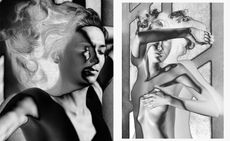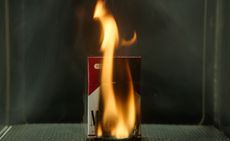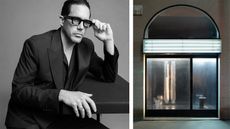Tanya Aguiñiga: the artist weaving new narratives for borderless creativity
We profile Tanya Aguiñiga, the LA-based artist and Loewe Foundation Craft Prize finalist, whose work explores life on the US-Mexico border and seeks to empower transnational voices

Tanya Aguiñiga knows a thing or two about living in flux. From the age of four, each morning at 3.30am, she travelled across the US-Mexico border from her home in Tijuana to her school in San Diego. ‘It’s crazy, logistically. But it’s also crazy, psychologically and emotionally,’ she tells me via Zoom from her LA studio, with off-white fibre works dangling from the half-moon wall behind her. ‘At the time, kind of similar to now, there were massive amounts of migrants at the border up against the fence trying to get to the US side. We had to navigate pretty difficult experiences on our way. There was incredible desperation on the faces of adults, and as a child, it’s super difficult to deal with.’
At the age of 18, Aguiñiga moved in with her grandmother in San Diego and settled in the US. ‘In a lot of our border towns, you’re constantly part of whatever journeys people are on. Mostly, that involves people’s really tragic journeys to get to the border,’ says the artist, who, because she was born in the US, was able to cross freely. ‘I constantly thought about my privilege, and I had a lot of guilt for being able to cross back and forth. It does, obviously, shape who you become.’

Texture samples in Aguiñiga’s studio
Aguiñiga’s wide-ranging practice spans sculpture, furniture and fashion design, immersive installations, performance, and community-based projects. Her art is far
from a solitary pursuit; her studio of seven years, a Second World War Quonset hut in LA’s Elysian Valley, has become a meeting point of sorts, for workshops, craft fairs, and to exhibit the work of other artists, particularly those marginalised.
‘When I came to see it, I thought it was the most amazing studio space I had ever seen, she says. ‘People are always like: “Are you in a spaceship?”’ Overlooking the LA River, it sits within a hive of activity, but not the sort you might expect for an incubator of cross-border creativity. ‘It's hard to ignore that I'm in a tow yard,’ says Aguiñiga. ‘I can hear arguments when people come to pick up their cars. The cops are usually here once a week to pick up stolen cars. There's a lot of tow yard activity.’

Tanya Aguiñiga outside her LA studio, a World War II Quonset hut next to a tow yard in Elysian Valley
From a young age, Aguiñiga felt a sense of duty to give back to her community. At the age of 19, while in community college, she met her mentor, Michael Schnorr, a member of activist art collective, Border Art Workshop/Taller de Arte Fronterizo, which, founded in 1984, sought to give voice to those at the politically charged meeting point of two countries. Aguiñiga witnessed how art could be used to bridge communities, alter narratives and empower change, and she began making collaborative installations with the group. ‘That immediately just exploded my head open,’ she recalls. ‘I had no idea that you could use art to help people.’
Aguiñiga first studied art at San Diego State University before going on to study furniture design at the Rhode Island School of Design, a decision informed by a desire to create something that was – as opposed to art – practical, and justifiable to her parents who had made sacrifices to facilitate her education. But then she began immersing herself in different craft-based processes. In 2007, she travelled through Mexico – from Oaxaca to the Mayan communities in Chiapas – to absorb the country’s ancient and multifarious history of ancestral craft that existed long before Spanish colonisation of the Americas.

Rope electroplated in copper, part of a large sculptural installation titled Feminine Occult

Preparatory terracotta castings of Aguiñiga’s hands
Informed by her experiences, Aguiñiga realised she had a choice: to use ‘comfortable’ European weaving technologies, or liberate her work from all that Western education had taught her, to ‘decolonise’ her practice. ‘After learning how to backstrap loom weave, I had a massive revelation: I was like “the body and materials are connected, and the material is a witness to whatever emotional or physical state the body is going through, the tension is recorded”,’ she recalls.
Wallpaper* Newsletter
Receive our daily digest of inspiration, escapism and design stories from around the world direct to your inbox.
Aguiñiga then began thinking about the ties we have to objects and territories,
and how art can be deployed as an accessible tool for protest, activism and community building. In 2016, Aguiñiga founded AMBOS (Art Made Between Opposite Sides), a platform that spotlights the experiences of binational artists. Although the non-profit AMBOS mostly operates in Tijuana, and Aguiñiga’s own practice within her LA studio, the two are fundamentally interwoven.
‘We fund AMBOS through the making of pretty things here,’ says Aguiñiga, who is currently co-ordinating two ceramic studios at LGBTQ asylum shelters in Tijuana through the initiative. ‘I’m thinking not just about what art can do, but what it’s for and who gets to participate,’ she says, noting the deeply-rooted, often class-based hierarchies in arts education. ‘It’s very rare that somebody who’s self-taught makes it this far. The language is exclusionary, the spaces are exclusionary, the skill levels for certain things are exclusionary, so I’m constantly trying to think of how I can knock down barriers. A lot of that comes from growing up on the border and how there are limits that people set on us. We shouldn’t have boundaries on our creativity.’

Terracotta structure tests which Aguiñiga will incorporate into weavings
Earlier this year, Aguiñiga was one of 30 finalists selected for the 2023 Loewe Foundation Craft Prize, and currently features in the prize’s exhibition at the Noguchi Museum, New York. It was something of a journey to get here. ‘I think I’ve applied maybe four times to the craft prize, and never make it in!’ Aguiñiga quips. ‘I was like, oh, the [projects] that get in are about mastery of skill. Connection to culture, yes, but mastery, that’s where I keep messing up! I was sending in stuff that was too loaded.’ Her shortlisted entry is Matriarchal Womb, which combines a deft command of materials with the cultural depth synonymous with the artist’s multifaceted practice. ‘
Matriarchal Womb skilfully layers textiles from distinct craft lineages, from crochet to coiling, as a metaphor for the bonds that exist between families and within communities. ‘It’s an intricate and poignant work’, says Jonathan Anderson, creative director of Loewe.

Matriarchal Womb is a homage to matrilineal support and the tender relationship between Aguiñiga and her daughter. Based on an outline of the two of them huddled together, it uses a variety of techniques, including off-loom weaving and crochet, while sections have been dipped in self-drying terracotta

Matriarchal Womb features in the Loewe Foundation Craft Prize exhibition at the Noguchi Museum, New York
Like many of Aguiñiga’s fibre works (including those currently on view in a solo exhibition at Chicago’s Volume Gallery), Matriarchal Womb uses off-loom woven, undyed cotton to signify the interconnected non-hierarchical relationships within communities. The knotted fibre, dipped in self-drying Mexican terracotta, represents ancient forms of communication in Mesoamerica, Aguiñiga’s own identity, and what it means to ‘have more brown objects in a very white space’. But at its core, the piece is about motherhood, womanhood and nurture. ‘In the beginning, it was about making spaces of care,’ she says. ‘I didn’t think I was going to make me and my daughter.’
Aguiñiga emphasises the importance of such prizes in broadening the conversation around global craft, and defending its validity as a device for storytelling against capitalism and hyper-commodification. ‘It’s important for people to know how many of us are still making stuff’, she concludes. ‘And that we care about craft, but also connecting with each other globally through what our hands can do.’ By carving space for non-hierarchical making, decolonised craft and borderless creativity, she is developing a practice that encompasses her own, and the voices of many, in pain, joy and solidarity.

Detail of weaving from Exercises in Understanding performance 2020, cotton dyed with pieces of the US/Mexico border fence

Glazed ceramic basket with rope netting filled with Los Angeles river grass
A version of this article appears in the July 2023 issue of Wallpaper*, on newsstands now and available to subscribers. Subscribe to Wallpaper* today
Matriarchal Womb is on show as part of the Loewe Foundation Craft Prize exhibition at the Noguchi Museum, New York, until 18 June, craftprize.loewe.com
Swallowing Dirt is on view at Volume Gallery, Chicago, until 17 June, wvvolumes.com, tanyaaguiniga.com
Harriet Lloyd-Smith was the Arts Editor of Wallpaper*, responsible for the art pages across digital and print, including profiles, exhibition reviews, and contemporary art collaborations. She started at Wallpaper* in 2017 and has written for leading contemporary art publications, auction houses and arts charities, and lectured on review writing and art journalism. When she’s not writing about art, she’s making her own.
-
 Three new coffee makers for a contemporary brew, from a casual cup to a full-on branded espresso
Three new coffee makers for a contemporary brew, from a casual cup to a full-on branded espressoThree new coffee makers, from AeroPress, Jura and Porsche x La Marzocco, range from the defiantly manual to the bells and whistles of a traditional countertop espresso machine
By Jonathan Bell Published
-
 Don't miss Luxembourg's retro-futuristic lab pavilion in Venice
Don't miss Luxembourg's retro-futuristic lab pavilion in VeniceAs the Venice Biennale enters its last few weeks, catch 'A Comparative Dialogue Act' at the Luxembourg Pavilion
By Amah-Rose Abrams Published
-
 A Berlin park atop an office building offers a new model of urban landscaping
A Berlin park atop an office building offers a new model of urban landscapingA Berlin park and office space by Grüntuch Ernst Architeken offer a symbiotic relationship between urban design and green living materials
By Michael Webb Published
-
 The seven best Los Angeles museums
The seven best Los Angeles museumsExplore LA's world-class museums, set within architectural masterpieces, lush gardens, and breathtaking viewpoints
By Kevin EG Perry Published
-
 Olafur Eliasson's new light sculptures illuminate Los Angeles
Olafur Eliasson's new light sculptures illuminate Los AngelesOlafur Eliasson's new exhibition, 'Open,' at the Museum of Contemporary Art in Los Angeles, includes 11 new pieces
By Hunter Drohojowska-Philp Published
-
 The lesser-known Los Angeles galleries contributing to a vibrant art scene
The lesser-known Los Angeles galleries contributing to a vibrant art sceneOutside of LACMA, MOCA and The Broad, these independent LA galleries are major players in the art world
By Kevin EG Perry Published
-
 Mona Kuhn’s love affair with Rudolph Schindler’s modernist LA home
Mona Kuhn’s love affair with Rudolph Schindler’s modernist LA home‘The Schindler House: A Love Affair’ features artist Mona Kuhn’s surreal-inspired silver prints evoking an impossible love
By Hunter Drohojowska-Philp Published
-
 Crisis point: Josh Kline's world is wiped out by climate change
Crisis point: Josh Kline's world is wiped out by climate changeJosh Kline's dystopian show is currently on at MOCA in Los Angeles
By Hannah Silver Published
-
 Loewe marks 100 years of the Surrealist Manifesto in Madrid
Loewe marks 100 years of the Surrealist Manifesto in MadridLoewe Foundation presents 'Surrealist Centennial' at the Leica Gallery, Madrid
By Hannah Silver Published
-
 Alexander May, founder of LA studio Sized, on the joys of creative polymathy
Alexander May, founder of LA studio Sized, on the joys of creative polymathyCreative director Alexander May tells us of the multidisciplinary approach that drives his LA studio Sized and its offspring, a 5,000 sq ft event space and an exhibition series
By Hannah Silver Published
-
 Los Angeles art exhibitions: the best shows to see in November
Los Angeles art exhibitions: the best shows to see in NovemberRead our pick of the best Los Angeles art exhibitions to see this month, from Doug Aitken's Lightscape at Walt Disney Concert Hall to Gustav Metzger at Hauser & Wirth
By Carole Dixon Last updated